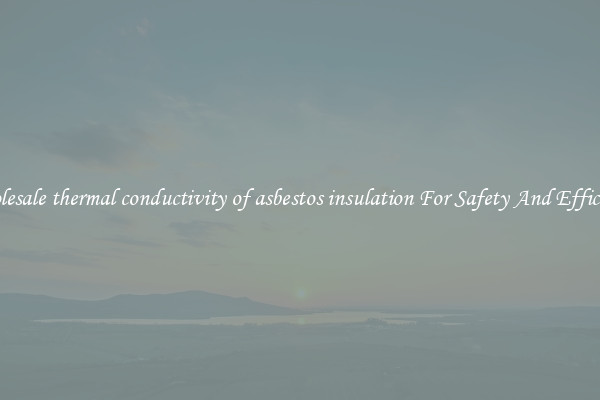Wholesale thermal conductivity of asbestos insulation For Safety And Efficiency
Wholesale thermal conductivity of asbestos insulation for safety and efficiency has been a controversial topic in recent years. Asbestos, a naturally occurring mineral, was once widely used in the construction industry for its excellent thermal insulation properties. However, due to its harmful effects on human health, including the development of lung diseases and cancer, the use of asbestos has been banned or severely restricted in many countries.

Thermal conductivity is a measure of how well a material conducts heat. A lower thermal conductivity means that a material is more effective at insulating against heat transfer. Asbestos has a relatively low thermal conductivity, which is one of the reasons why it was used as insulation in buildings.
However, the health risks associated with asbestos exposure have led to its removal from many buildings. Inhalation of asbestos fibers can cause lung diseases such as asbestosis and mesothelioma, a rare and aggressive form of cancer. These health risks have led to a global effort to eliminate the use of asbestos in construction and insulation materials.
In recent years, alternative materials with low thermal conductivity have been developed to replace asbestos insulation. One such material is fiberglass, which is made from fine fibers of glass. Fiberglass has excellent thermal insulation properties, comparable to those of asbestos, but without the health risks. It is now widely used as a safer alternative to asbestos insulation.
While wholesale thermal conductivity of asbestos insulation may still be appealing from an efficiency standpoint, it is crucial to prioritize safety. The health risks associated with asbestos exposure far outweigh any potential benefits in terms of insulation efficiency. Choosing alternative materials that provide similar thermal conductivity but without the hazardous effects on human health is the only responsible course of action.
Fortunately, there are numerous asbestos removal and remediation services available to ensure the safety of buildings that still contain asbestos insulation. These services involve the safe removal and disposal of asbestos-containing materials, minimizing the risk of exposure to harmful fibers.
In conclusion, the wholesale thermal conductivity of asbestos insulation should not be prioritized over safety and health concerns. While asbestos may have excellent thermal insulation properties, its hazardous effects on human health make it an unacceptable choice for insulation materials. It is essential to opt for safer alternatives, such as fiberglass, that provide comparable thermal conductivity without the associated health risks. By prioritizing safety and efficiency, we can create a healthier and more sustainable built environment for future generations.

View details

View details

View details

View details








